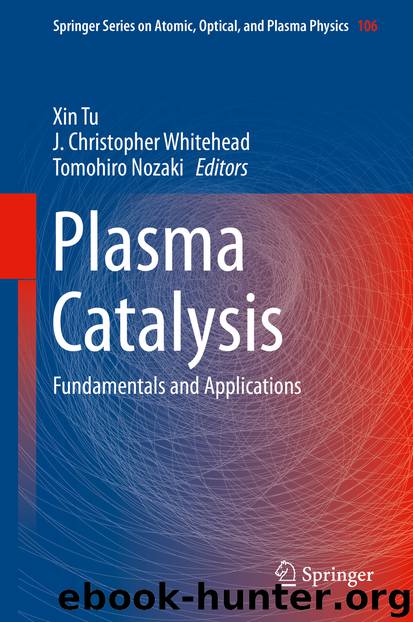Plasma Catalysis by Unknown

Author:Unknown
Language: eng
Format: epub
ISBN: 9783030051891
Publisher: Springer International Publishing
6.3.3 Trichloroethylene
TCE is a commonly used solvent in industry but is considered highly controversial, as it is a known carcinogenic and nonhuman health hazard. Therefore, its abatement is one of the most studied processes in IPC and PPC.
Oda et al. studied the use of manganese oxide in a PPC configuration [96]. The effect of direct processing of the contaminated waste stream was compared to indirect processing, where plasma-treated clean air was mixed with the waste stream. Results show that manganese oxide is sufficiently effective to improve the abatement efficiency in both cases, as it is a known ozone dissociator, generating in both cases a sufficiently high concentration of oxygen radicals to efficiently break down the TCE molecular structure. Also, Han et al. studied the synergetic effect of PPC and MnO2 on the direct and indirect processing of TCE-containing waste streams [215]. The main component generated during the direct processing of the waste stream is dichloroacetylchloride (DCAC), a result from the collisions between plasma species and O2. Compared to the indirect process, the degradation efficiency is higher due to the oxidation of the rest-TCE into tricholoracetaldehyde by atomic oxygen generated from the dissociation of ozone at the MnO2 catalyst surface. When increasing the energy density from 120 J/L to 400 J/L, the COx yield was further increased from 35% to 98%.
Oda et al. also studied IPC, using the photocatalytic TiO2 [216]. The effect of initial TCE concentration, sintering temperature for TiO2, and pellet size on the TCE abatement performance were investigated. When the sintering temperature for TiO2 was changed from 1100 °C to 400 °C, the breakdown voltage needed to generate the NTP was significantly lowered. The authors suggested that the electric field was disturbed by the non-uniformity of the disk-like pellets, resulting in a more concentrated electric field at the contact points of the pellets. This gave cause to the formation of contact point discharges, which decreased the breakdown voltage and thus improved the overall energy efficiency of the system. A decrease of the pellet size affected the gas flow distribution, resulting in an incomplete filling of the active area with plasma.
Magureanu et al. used a DBD system which consisted of an inner electrode fabricated from sintered MF and coated with different transition metal oxides [64]. CO2 and CO selectivity were studied for a range of energy densities and they found that the MF as such reached a CO2 selectivity of 25%. Though, when combined with a manganese oxide coating, selectivity increased to 60%. Unfortunately, the use of manganese oxide in combination with the MF did not decrease the selectivity toward CO. The explanation as to why this change in selectivity could be observed was again assigned to the production of atomic oxygen from ozone adsorbed on MnO2. The active oxygen is considered to be responsible for the enhanced oxidation of TCE, thus leading to a higher selectivity toward CO2 [51, 64, 68]. X-Ray photoelectron spectroscopy (XPS) analysis of the catalyst surface after running the system showed that both Fe and Mn did not change their oxidation state.
Download
This site does not store any files on its server. We only index and link to content provided by other sites. Please contact the content providers to delete copyright contents if any and email us, we'll remove relevant links or contents immediately.
| Automotive | Engineering |
| Transportation |
Whiskies Galore by Ian Buxton(41935)
Introduction to Aircraft Design (Cambridge Aerospace Series) by John P. Fielding(33085)
Small Unmanned Fixed-wing Aircraft Design by Andrew J. Keane Andras Sobester James P. Scanlan & András Sóbester & James P. Scanlan(32763)
Craft Beer for the Homebrewer by Michael Agnew(18193)
Turbulence by E. J. Noyes(7977)
The Complete Stick Figure Physics Tutorials by Allen Sarah(7334)
Kaplan MCAT General Chemistry Review by Kaplan(6896)
The Thirst by Nesbo Jo(6876)
Bad Blood by John Carreyrou(6580)
Modelling of Convective Heat and Mass Transfer in Rotating Flows by Igor V. Shevchuk(6406)
Learning SQL by Alan Beaulieu(6235)
Weapons of Math Destruction by Cathy O'Neil(6205)
Man-made Catastrophes and Risk Information Concealment by Dmitry Chernov & Didier Sornette(5951)
Digital Minimalism by Cal Newport;(5698)
Life 3.0: Being Human in the Age of Artificial Intelligence by Tegmark Max(5506)
iGen by Jean M. Twenge(5384)
Secrets of Antigravity Propulsion: Tesla, UFOs, and Classified Aerospace Technology by Ph.D. Paul A. Laviolette(5330)
Design of Trajectory Optimization Approach for Space Maneuver Vehicle Skip Entry Problems by Runqi Chai & Al Savvaris & Antonios Tsourdos & Senchun Chai(5036)
Pale Blue Dot by Carl Sagan(4949)
